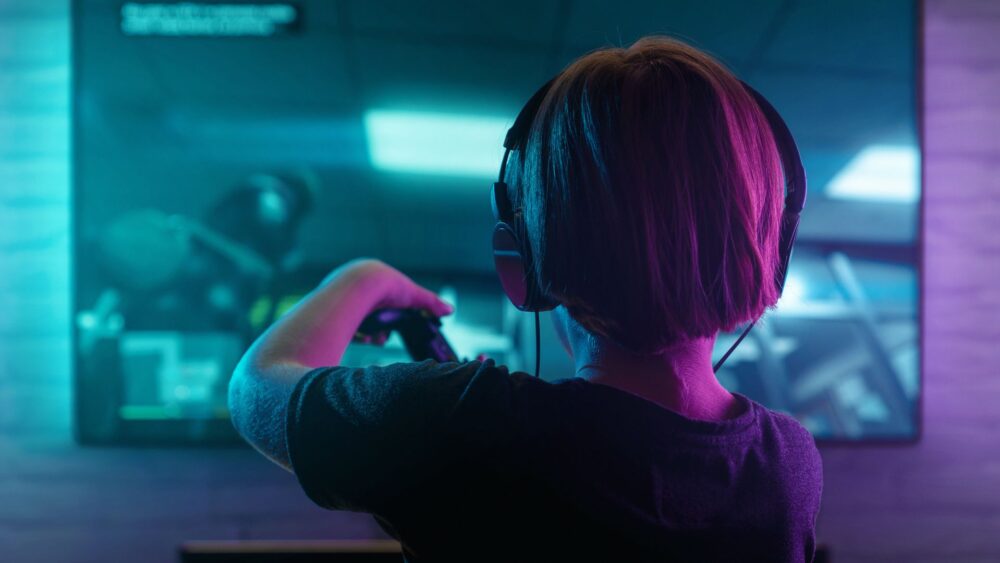Use parental controls like training wheels to keep young players safe
KEY POINTS
- Gaming can be a healthy pastime, fostering resilience, social skills, and cognitive development.
- Many consoles and gaming ecosystems offer parents multiple levels of control.
- Parental controls should be used as training wheels, providing structure until players mature.
- Discussing parental restrictions with your kids, and adapting them as kids mature, builds trust and teaches values.
The top questions I get from parents are about screen time, most of them driven by fear. Screen time is today’s bogeyman, the monster under the bed. We blame it for everything from depression and anger to poor body image. Restricting screen time has become a badge of good parenting. But screen time isn’t real. It’s a euphemism for the technologies we’re currently worried about and overlooks the ones we aren’t. Video games are on the “things we worry about” list. While it should be comforting to know that gaming research shows a more positive picture than the dire warnings of the past, positive gaming experiences are all about balance. All parents can use built-in parental controls to help manage kids’ gaming experiences, ensuring they’re age-appropriate and balanced. Using them lets parents of young gamers exhale and approach gaming as a potential positive rather than just a necessary evil. Below, you’ll find:
- Some of the main benefits of gaming,
- An overview of the types of parental controls available in gaming systems and ecosystems
- 6 tips to approach gaming with your kids so they can play and stay happy and safe.
Is Gaming a Waste of Time?
It’s easy to see gaming as a waste of your kids’ time, especially if you were never a gamer. A 2020 poll of 2000 parents found that 9 out of 10 thought their teens spent too much time playing video games—and that was before COVID-19 (Mott Poll Report, 2020). Early studies focused on the negative impacts of games, as researchers tend to do with new technology. The research was more successful in creating parent anxiety and providing political scapegoats than establishing any consistent findings or meaningful effect sizes. Contrary to the South Park stereotype of gamers as socially isolated guys in the basement, many games encourage social interaction through online multiplayer features or in-game decision-making, and solo games are rarely played in isolation as prowess in gaming is valuable social capital in kid culture.
Studies show that age-appropriate, moderate use of video games promotes emotional well-being and social connections (Johannes et al., 2021). For example, Fortnite’s cooperative modes require effective communication and teamwork to win. Video games can help children build emotional resilience. Failing and restarting levels or missions teach persistence and the value of learning from mistakes, essential life skills that can be applied outside gaming. (As an aside, we worry a lot about negative feedback damaging kids’ self-esteem, and while this is a separate discussion, kids’ motivation is not diminished if they don’t level up on the first try. It’s no fun and no accomplishment if it’s too easy.) Video games’ other documented benefits include developing cognitive skills, relieving stress, combatting loneliness, and dealing with trauma. Multiple studies show that gaming helped players cope with the effects of COVID-19 (Barr, 2019).

Parental Tools at Your Disposal
Many video game companies have responded to demands for more robust parental controls. According to the Entertainment Software Rating Board (ESRB), about 50% of parents they asked were familiar with monitoring features in the games their kids play, as well as the in-game community guidelines. (Other non-vested interest sources support this number.) Awareness is not the same as knowing how to use the controls or to make age-appropriate adaptations. And the ENRB agrees that more work is needed to make parents better able to use the tools available to them. Kids are often more technically facile than older generations, having hands-on experience from a much younger age. The ability to navigate Minecraft does not mean kids understand how online ecosystems work or grasp the importance of secure online behavior. If 50% of parents know how to use parental controls, 50% don’t.
Parental Controls in Gaming Systems
Consoles like Xbox and PlayStation offer robust parental controls that can augment those in individual games. These can include time limits, spending caps, and content filters. The ESRB website has detailed instructions on how to set specific restrictions. See their “Tools for Parents.” https://www.esrb.org/tools-for-parents/parental-controls/.
Microsoft’s Xbox Family Settings
Microsoft offers tools where parents can manage screen time and set content filters and privacy settings. The Xbox Family Settings app allows parents to receive activity reports to monitor playtime on games and set time limits across devices.
Sony’s PlayStation Safety
Sony’s PlayStation systems come with a Parental Controls and Family Management system. Parents can set levels of game restrictions, such as rules on the use of the internet browser, spending limits on the PlayStation Store, parental approval of friends, and managing playtime.
Nintendo Switch Parental Controls
Nintendo’s Switch has user-friendly parental controls with a dedicated smartphone app enabling parents to set time limits, monitor gameplay, and get push notifications of new friends or when the console is activated. The app can also automatically suspend a game when the time limit is reached.
Parental Controls in Online Gaming Ecosystems
Epic Games’ Fortnite
Epic Games offers a variety of parental controls due to concerns and pushback over the wide age range of the players and concerns about predators. Parental controls include settings that limit who their children can receive messages from and who they can talk to. Through a parental control dashboard, parents can view recent play, limit playtime schedules, and set up an approval requirement to prevent unauthorized in-game spending. The company also follows COPPA (Children’s Online Privacy Protection Act) regulations.
One of Epic Games’ unique features is their “cabined accounts,” which enable parents to set up specific restrictions for underage players, such as limiting in-game purchases, blocking certain types of content, and monitoring their child’s activity in the game.
Minecraft
Minecraft offers similar parental controls to Fortnite, such as chat filters and customizable privacy settings. However, the game doesn’t natively provide time management features like Epic Games. Parents would have to rely on external software or device settings for this function.
Roblox
Roblox provides a wide range of parental controls, including options to restrict chat, enforce an age-appropriate “safe chat” mode, and limit gameplay to a curated list of age-appropriate games. Similar to Epic Games, Roblox also complies with COPPA regulations.
6 Ways to Keep Video Games Safe and Fun
The key to keeping your kids’ online experiences positive and enriching experiences is to remain actively involved. Here are some tips to help you think about
- Stay Informed and Involved. Familiarize yourself with the games your children are playing. Ask questions to find out what they like about their favorite game. Be curious. Ask if you can play the games with them. (Kids love being the “expert” and teaching their parents stuff.)
- Teach Digital Literacy and Etiquette. Equip your children with the understanding that their actions online should mirror their actions in real life with respect and kindness. Trash-talking, common in gaming environments, is a good topic that lets you talk about peer pressure and the emotional impact of name-calling and harassment. It may seem harmless but can be emotionally painful, not to mention creating antisocial communication behaviors. Help them brainstorm coping and behavioral strategies.
- Encourage Self-Awareness and Critical Thinking. Awareness of physical and mental states, such as fatigue or negative emotions, is the first step to teaching self-regulation.
- Set Boundaries and Use Age-Appropriate Parental Controls. Use the tools on these platforms provide to set healthy boundaries and be prepared to review and discuss them as your kids mature. Talk to your kids about the restrictions you’re setting (and why) and establish clear rules about playtime, in-game purchases, and online interaction. Don’t forget to listen to their point of view.
- Encourage balance. Recognize that gaming can serve many functions–entertainment, social, skill-building–but encourage breaks, physical activity, reading, and socializing in the real world.
- Be a Role Model. Kids learn by example. Manage your own devices, whether it’s games or checking email, and demonstrate a balanced approach to media and technology. “Do as I say and not as I do” is not an effective argument for behavior change.
The Importance of Parental Controls
Parental controls should not be your police force when you can’t be there. They should be a mechanism for providing structure and guidance. However, most of all, reviewing the controls will get you to think about each setting, what’s important to you, and how it relates to your child and your family. Whether you use them to regulate playing time, limit exposure to inappropriate content, manage in-game purchases or friend access, or just start a discussion, they can help you establish clear rules and boundaries and keep both you and your child on the same page. Don’t use parental controls to ‘stealth parent.’ Make sure kids know what you’re doing and why. You won’t always be there to set parental controls. I can’t tell you how many kids get to college and crash and burn because they never developed self-regulation. It’s vital to build trust, have open conversations, and teach your child skills at each step so they can reap the benefits of video games while minimizing the risks.
Next up: Age-Appropriate Parental Controls for Each Developmental Stage.
Cyberwise Chats: Each month, Diana Graber and I host a Cyberwise Chat addressing parent and teacher questions on kids and technology. In November, we’ll be chatting with Candela Montero, Senior Director of Public Policy at Epic Games, to hear their approach to creating a safe game experience for players of all ages. All webinars are free. Find out more at https://www.cyberwise.org/cyberwisechats
References
Barr, M. (2019). Reflections on game-based learning. In Graduate skills and game-based learning: Using video games for employability in higher education (pp. 127-155). Springer International Publishing. https://doi.org/10.1007/978-3-030-27786-4_5
Johannes, N., Vuorre, M., & Przybylski, A. K. (2021). Video game play is positively correlated with well-being. Royal Society Open Science, 8(2), 202049. https://doi.org/doi:10.1098/rsos.202049
Mott Poll Report. (2020). Game on: Teens and video games. C.S. Mott Children’s Hospital, University of Michigan. https://mottpoll.org/sites/default/files/documents/012020_VideoGames.pdf

 Dr. Pamela Rutledge is available to reporters for comments on the psychological and social impact of media and technology on individuals, society, organizations and brands.
Dr. Pamela Rutledge is available to reporters for comments on the psychological and social impact of media and technology on individuals, society, organizations and brands.